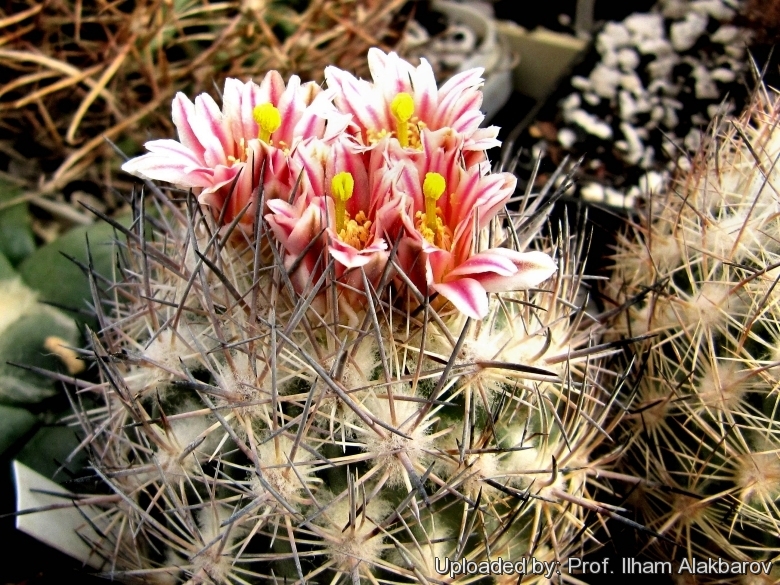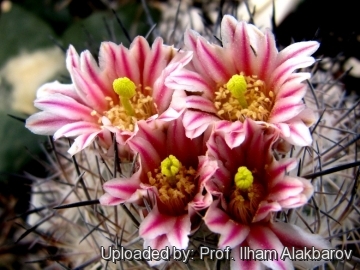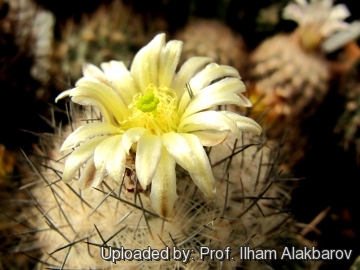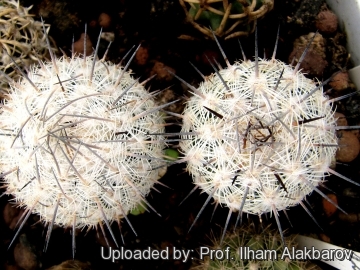




Your support is critical to our success.
Acta Mus. Richnov., Sect. Nat. 5(1): 24 1998
Family: CACTACEAE
Accepted Scientific Name: Echinomastus mariposensis Hester
Desert Pl. Life 17: 59 1945

Origin and Habitat: Coahuila, Mexico and Big Bend region of Texas, USA. In Texas, it is known from about 30 sites, many within Big Bend National Park and Black Gap Wildlife Management Area.
Altitude: 250 to 1500 metres above sea level.
Habitat and Ecology: Echinomastus mariposensisSN|32469]]SN|26084]] grows in the open sun or among shrubs and rosette-forming perennials in rocky, gravelly soils on arid limestone slopes and flats in the Chihuahuan Desert, primarily on the Boquillas Formation in sotol-lechuguilla (Dasylirion leiophyllum, Agave lecheguilla) shrublands, it does not occur in the adjacent parts of the habitat where the rock is gypsum, and the related Echinomastus warnockiiSN|26084]]SN|32469]] fills its niche there. This species is associated with: Fluorensia cernua, Forestiera angustifolia, Acacia schottii, Yucca rostrataSN|27871]]SN|27871]], Larrea tridentata, Agave lechuguilla, Ephedra viridis, and many other small cactus species like Astrophytum niveumSN|3659]]SN|3659]], Echinocereus pectinatusSN|8503]]SN|8503]], Echinocactus horizonthaloniusSN|1711]]SN|1711]], Coryphantha ramillosaSN|10393]]SN|10403]], Coryphantha pseudoechinusSN|10403]]SN|10393]] and Lophophora williamsiiSN|1117]]SN|1117]]. The species has a very wide range and is abundant throughout its range. There is some illegal collection from wild populations, but it is localized and does not pose a major threat. Large tracts of land in the vicinity of the Mariposa Mine have been wiped clean of all cacti by the hired hands of cactus collector entrepreneurs. These "business people" have the cacti dumped in large piles to be sorted later for sale. Many of the cacti die while in the pile, or during shipment. Many others die due to improper care by well-meaning individuals who are ignorant of the special requirements of cacti.
Synonyms:
- Echinomastus mariposensis Hester
- Neolloydia mariposensis (Hester) L.D.Benson
- Pediocactus mariposensis (Hester) Halda
- Sclerocactus mariposensis (Hester) N.P.Taylor
Echinomastus mariposensis Hester
Desert Pl. Life 17: 59 1945
Synonymy: 4
- Echinomastus mariposensis Hester
- Neolloydia mariposensis (Hester) L.D.Benson
- Pediocactus mariposensis (Hester) Halda
- Sclerocactus mariposensis (Hester) N.P.Taylor
Echinomastus mariposensis subs. fischeri Halda & Sladk.
Acta Mus. Richnov., Sect. Nat. 7(1): 35. 2000
ENGLISH: Lloyd's Mariposa Cactus, Mariposa Cactus, Mariposa Lloyd's Cactus, Golfball Cactus, Lloyd's Fishhook Cactus, Silver Column Cactus, Mariposa Viszagita, Lloyd's Mariposa
SPANISH (Español): Biznaga-bola de Mariposa
Description: Echinomastus mariposensisSN|26084]]SN|26084]] is a small, rounded cactus with single stems commonly about the size of a golf ball, but may grow to about 10-15 cm tall, and 8 cm in diameter at maturity. The plant has a grayish appearance overall, and on closer inspection, delicate, brown-tipped central spines can be seen arising from the many-spined tubercules.
Stem: Globose to egg-shaped, blue-green, (3-)6-10 cm high, (3-)4-6 cm in diameter, densely covered by spines.
Ribs: Not evident, approx 21 strictly tuberculate.
Tubercles: Narrowly pointed, to 5 mm long.
Areoles: 6-12 mm apart along ribs; areolar glands absent.
Spines : 23-30 per areole, pale tan to grayish white, largest spines often tipped "chalky" or "dusty" blue-gray, blue-black or brown.
Radial spines: (19-)23-26(-30), whitish, radiating horizontally, overlapping and pressed closely to the stem, (3-)4-6(-11) mm long, the upper and lateral the longest.
Central spines: 2-4(-6), erect or ascending, often slightly curved toward stem apex with bulbous base, whitish, often becoming dark with age, lower one turning downward, 15-20 mm long. Immature plants have only two central spines, one above the other, both 3 mm, resembling immature Coryphantha tuberculosaSN|10190]]SN|10190]] or Mammillaria pottsiiSN|9355]]SN|9355]].
Flowers: Not particularly showy or large, clustered at the apex of stems, broadly funnelform, pink,2,2-2,5 cm long, 2-4 cm in diameter. Inner perianth segments pink to white with distinct greenish to reddish purple midribs, outer ones brown-tinged. Filaments colourless to pink. The stigmas lobes are green or yellow-green. Style pale-green.
Blooming season: It blooms in February and March and fruits ripen in April. Flowers open midday, close at night, and reopen on warm, sunny days for 3-4 days.
Fruits: Light green or yellowish, hort oblong or globose about 12 mm long and 8 mm in diameter, formed beneath the apical spines, indehiscent or disintegrating irregularly and do not dry at maturity.
Seeds: Black, subglobular, papillate, 1,6-2 mm broad.
Chromosome number: 2n = 22.
Notes: Although the common name of this species is the Spanish word for butterfly, the cactus is actually named after the locality where it was first discovered, the Mariposa Mine in southern Brewster County.
Bibliography: Major references and further lectures
1) Edward Anderson “The Cactus family” Timber Press, Incorporated, 2001
2) James Cullen, Sabina G. Knees, H. Suzanne Cubey "The European Garden Flora Flowering Plants: A Manual for the Identification of Plants Cultivated in Europe, Both Out-of-Doors and Under Glass" Cambridge University Press, 11/Aug/2011
9) David R Hunt; Nigel P Taylor; Graham Charles; International Cactaceae Systematics Group. "The New Cactus Lexicon" dh books, 2006
10) Brian Loflin, Shirley Loflin “Texas Cacti: A Field Guide” Texas A&M University Press, 26/ott/2009
11) Albert Michael Powell, James F. Weedin “Cacti of the Trans-Pecos and Adjacent Areas” Texas Tech University Press, 2004
12) Del Weniger “Cacti of the Southwest: Texas, New Mexico, Oklahoma, Arkansas, and Louisiana” University of Texas Press, 1969
13) “Rare Plants of Texas: A Field Guide” Texas A&M University Press, 2007
14) Roland H. Wauer, Carl M. Fleming “Naturalist's Big Bend: An Introduction to the Trees and Shrubs, Wildflowers, Cacti, Mammals, Birds, Reptiles and Amphibians, Fish, and Insects“ Texas A&M University Press, 2002
15) Texas Parks and Wildlife Department “Lloyd's Mariposa Cactus (Sclerocactus mariposensis)” <www.iucnredlist.org>. Downloaded on 15 February 2014.
16) Heil, K. & Terry, M. 2013. Sclerocactus mariposensis. In: IUCN 2013. “IUCN Red List of Threatened Species.” Version 2013.2. <http://www.tpwd.state.tx.us>. Downloaded on 15 February 2014.
17) Center for Plant Conservation “CPC National Collection Plant Profile: Echinocactus mariposensis” <http://www.centerforplantconservation.org>. Downloaded on 15 February 2014.
18) Flora of North America. “Echinomastus mariposensis” <http://www.efloras.org>. Downloaded on 15 February 2014.
19) Benson, L. 1969. "Cacti of Arizona." Tuscon, AZ: The University of Arizona Press. 218p.
20) Benson, L. 1982. "The Cacti of the United States and Canada." Stanford, California: Stanford University Press. 1044p.
21) Correll, D.S.; Johnston, M.C. 1970. "Manual of the vascular plants of Texas." Renner: Texas Research Foundation. 1881p.
22) Kartesz, J.T. 1993. "Species distribution data for vascular plants of 70 geographical areas, from unpublished data files at the North Carolina Botanical Garden."
23) Kartesz, J.T. 1996. "Species distribution data at state and province level for vascular plant taxa of the United States, Canada, and Greenland (accepted records), from unpublished data files at the North Carolina Botanical Garden."
24) Poole, J.M.; Riskind, D.H. 1987. "Endangered, threatened, or protected native plants of Texas." Austin, TX: Texas Parks Wildlife Department.
25) Warnock, B.H. 1977. "Wildflowers of the Davis Mountains and the Marathon Basin, Texas." Alpine, Texas: Sul Ross State Univ. 274p.
26) Weniger, D. 1984. "Cacti of Texas and neighboring states: a field guide." Austin: University of Texas Press. 356p.
27) Kartesz, J.T. 1999."A synonymized checklist of the vascular flora of the U.S., Canada, and Greenland." In: Kartesz, J.T.; Meacham, C.A., editors. Synthesis of the North American Flora, Version 1.0. North Carolina Botanical Garden. Chapel Hill, NC.
28) Anderson, E.F. 1986. "A revision of the genus Neolloydia B. & R. (Cactaceae)." Bradleya. 4: 1-28.
29) Benson, L. 1966. "A revision of Sclerocactus." Cactus and Succulent Journal of America. 38: 54-55.
30) Hester, J. 1945. Echinomastus mariposensis. Desert Plant Life. 17: 59.
31) Schmalzel, R.J.; Reichenbacher, F.W.; Rutman, S. 1995. "Demographic study of the rare Coryphantha robbinsorum (Cactaceae) in southeastern Arizona". Madroño. 42, 3: 332-348.
32) Tepedino, V.J. 1997. "Wild Bees and Floral Jewels." Wings. 20, 1: 8-10.
33) Tepedino, V.J. 2000. "Wild Bees and Floral Jewels." Castilleja: The Newsletter of the Wyoming Native Plant Society. 19, 4: 6-8.
34) Brack, S. 1986. "Germination Tips." Belen, NM: Mesa Garden. p.5.
35) Heil, K.D.; Brack, S.; Porter, J.M. 1985."The rare and sensitive cacti of Big Bend National Park." Big Bend National Park, Texas. p.41.
36) McKinney, B.R. 1995. "The status of Neolloydia mariposensis (Lloyd's mariposa cactus) on the Black Gap Wildlife Management Area, Brewster County, Texas." Brewster County, Texas: Texas Park and Wildlife Dept. p.13 + maps.
37) USFWS. 1989. "Recovery plan for the Lloyd's mariposa cactus, Neolloydia mariposensis (Hester) L. Benson." Albuquerque, New Mexico: U.S. Fish and Wildlife Service. p.47.
38) Weniger, D. 1979. "Status report on Neolloydia mariposensis." Albuquerque, New Mexico: U.S. Fish & Wildlife Service.

Pediocactus mariposensis (Echinomastus mariposensis) Photo by: Prof. Ilham Alakbarov

Pediocactus mariposensis (Echinomastus mariposensis) Photo by: Prof. Ilham Alakbarov

Pediocactus mariposensis (Echinomastus mariposensis) Photo by: Prof. Ilham Alakbarov

Pediocactus mariposensis (Echinomastus mariposensis) Photo by: Prof. Ilham Alakbarov
Cultivation and Propagation: Echinomastus mariposensisSN|26084]]SN|26084]] is a most beautiful cactus but rarely seen in cultivation. It is quite difficult to grow on its own roots. Very easily rot! It’s thought that’s better to watch this species in photo or in the natural habitat rather than to try to cultivate it. For this reasons the plant is often grafted on a frost hardy stock.
Soil: Use mineral well-permeable substratum with very little organic matter (peat, humus). It needs perfect drainage to flourish.
Repotting: Repotting every 2-3 years. As it is especially prone to rot under-pot in a smaller container filled with very porous compost. Use pot with good drainage.
Exposition: This plant need full sun and above all a very good ventilation, especially in winter. Tends to bronze in strong light, which encourages flowering and heavy spine production.
Watering: Water sparingly during the growing season and keep totally dry during winter. In the rest period no high atmospheric humidity!!Care must be taken with watering as they tends to become swollen and untidy in growth habit if given too much water and shade.
Fertilization: During the growing season enrich the soil using a fertilizer rich in potassium and phosphorous, but poor in nitrogen, because this chemical element doesn’t help the development of succulent plants, making them too soft and full of water.
Hardines: It can tolerate temperature below zero (-15° C or less).
Pests & diseases: It may be attractive to a variety of insects to watch for:
- Red spiders: Sensitive to red spider mite. Overhead watering is helpful in controlling mites.
- Mealy bugs: Occasionally mealy bugs they develop aerial into the new growth among the wool with disfiguring results, but the worst types develop underground on the roots and are invisible except by their effects.
- Rot: Rot it is the major threat. If the plants are not watered and “aired” correctly, fungicides won't help all that much. Mature individuals - if the growing conditions are not optimal, easily rot and die.
Remarks: Displaying your cacti on shelves has the added benefit of keeping them off the ground and away from potential rodent or snail damage.
Propagation: Seed or grafting. Seeds germinate in 7-14 days at 21-27° C in spring, remove the glass cover gradually as the plants develops and keep ventilated, no full sun for young plants! The seedlings should not be disturbed until they are well rooted, after which they can be planted separately in small pots. Seeds are relatively difficult to germinate (only a limited percentage of seeds germinate). Grafting is often used to speed growth rate and to create a back-up for plants in collection.
| Your Actions | |
|---|---|
| Back to Pediocactus index | |
| Back to Cactaceae index | |
 |
Back to Cacti Encyclopedia index |
Privacy stantement - Terms and conditions - How to cite - About us - Feedback - Donate



